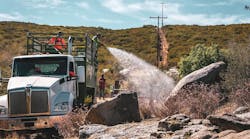Utilities are not the cause for the majority of wildfires, but those ignited by utilities have turned into some of the most devastating wildfires in U.S. history. Many of these fires have occurred in recent years, including 2020, which was one of the most active wildfire seasons on record. The 2021 wildfire season could be even worse in the Western United States, with California reporting that precipitation in the state was 30% to 70% lower than normal during the first five weeks of the year.
Western states are becoming more diligent in their prevention efforts when it comes to wildfires. In the state of Washington, Commissioner of Public Lands Hillary Franz and Rep. Larry Springer (D-Kirkland) recently introduced House Bill 1168 to create a dedicated funding source to address wildfires that will be allocated $125 million every two years. In California, Governor Gavin Newsom has included $1 billion in his 2021-2022 budget proposal to reduce wildfire risk for vulnerable communities. And, a group of California utility companies have announced in their Wildfire Mitigation Plans (WMPs) that they are investing approximately $13 billion to mitigate the risk of wildfires across the Golden State.
With governments and private industry putting all this financial weight behind addressing wildfires, there are numerous options on how to invest these additional dollars behind solutions that help to prevent wildfire ignitions. Drones, high-definition cameras, and sensors are all being introduced to more rapidly detect wildfires once they start. Some utilities are even turning to Public Safety Power Shutoff (PSPS) events to prevent wildfire ignitions in the face of red flag warnings and what could prove to be devastating wildfires if utility infrastructure were to fail. PSPS events cost billions of dollars annually in unseen losses, and potentially even contribute to the loss of life for those that rely on electric power.
These options work to varying degrees, but in order to make real strides in protecting people and property from wildfires, we need more solutions that help prevent wildfire ignitions in the first place. This will reduce reliance on sensory and detection devices and limit the need for utility companies to resort to turning off power to millions of utility customers.
When considering options for preventing wildfire ignitions, utility companies are starting to take a closer look at ground-applied long-term fire retardants (LTR). Today’s LTR solutions are approved by the USDA to fight wildland fires, with a Final Environmental Impact Statement (EIS) and National Environmental Policy Act (NEPA) analysis completed. Certain long-term fire retardants are more durable and provide up to season-long protection with one application.
Utility companies can use LTR in a variety of ways to prevent ignitions and to protect critical infrastructure, including:- Around poles in place of banned herbicides
- Part of Enhanced Vegetation Management (40-50 ft from poles)
- Preventatively protecting assets (substations, towers, solar, hydro, and nuclear sites)
- Protecting assets in the event of an approaching fire (Rapid Response)
- Protecting assets and communities alongside prescribed burns
- Protecting utility personnel and ingress/egress routes
With these new technology advancements to LTR, the paradigm for wildfire management has changed from reactive suppression to proactive prevention, which will help provide better protection for first responders and communities. Making the transition to proactive prevention also helps utility companies with risk management, as it helps lower insurance risk, reduces the investment they need to make for vegetation management, and will limit the number of PSPS events they are forced to activate—potentially saving utility customers billions of dollars.
Over the next few years, there will be more pressure put on utilities to perform infrastructure hardening – burying lines underground, insulating lines, using non-wood poles and reconfigured insulators. Researchers have indicated that the costs of completing these projects will require an investment between $100 billion and $500 billion, and that it won’t be done for at least another ten years.
Long-term retardant can help utilities to bridge the gap until the infrastructure hardening is completed. The Electric Power Research Institute (EPRI) recognizes the need for this solution, and has created a supplemental project, asking its utility member companies to work with them to demonstrate the efficacy of ground-applied LTR in preventing wildfire ignitions and their spread to communities. Protecting people is more important than protecting property, and utility companies can have an active role in doing that by participating in this project and incorporating LTR into their wildfire prevention and protection strategies.
For more information, check out T&D World's PowerUp series: "Mitigating Wildfires with Breakthrough Long-Term Retardants: Protecting Assets, Ignition Prevention, and Risk Management;" Wednesday, April 21, 2021, 1:00 PM - 2:00 PM. Register here.


